

Cuban Aviators, I PartRogelio Acevedo, Enrique Carreras Rolas, Julio Casas Regueiro, Jaime González Grocier, Rubén Martínez Puente, Pedro J. Mendiondo GómezRuben Urribarres |
Division General, President of the Cuban Civil Aeronautical Institute
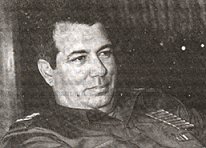 Acevedo
born in 1941 in Caibarien, in the old province of Las Villas. After the Castro's
landing in 1956, he participates in some revolutionary actions. In 1957 with at
the age of 16 years, he joins with the guerrilla, in a unit under the command
of the Che Guevara. In the actions of Pino del Agua and the Jigue he foughts in
the troops of Fidel already as lieutenant. Acevedo participates in the invasion
to the western fighting in the 'Columna invasora N°8 "Ciro Redondo" of the
Che Guevara. He finishes the war in 1959 as captain, and is sent to direct the
military school "Camilo Cienfuegos". In 1960 he is appointed as National Director
of the new created National Revolutionaries Militias (MNR), of contributing decisive
in them you fight by Bahia of Pigs. It occupies diverse charges in the Armed Forces,
including that head of the Political Direction of the FAR.
Acevedo
born in 1941 in Caibarien, in the old province of Las Villas. After the Castro's
landing in 1956, he participates in some revolutionary actions. In 1957 with at
the age of 16 years, he joins with the guerrilla, in a unit under the command
of the Che Guevara. In the actions of Pino del Agua and the Jigue he foughts in
the troops of Fidel already as lieutenant. Acevedo participates in the invasion
to the western fighting in the 'Columna invasora N°8 "Ciro Redondo" of the
Che Guevara. He finishes the war in 1959 as captain, and is sent to direct the
military school "Camilo Cienfuegos". In 1960 he is appointed as National Director
of the new created National Revolutionaries Militias (MNR), of contributing decisive
in them you fight by Bahia of Pigs. It occupies diverse charges in the Armed Forces,
including that head of the Political Direction of the FAR.
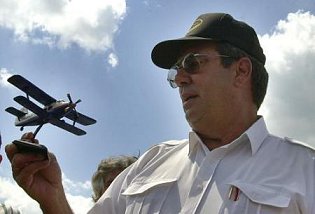 General Acevedo with a An-2 model, after a similar airplane crashed
in Marth 2002 (AP Photo/Cristobal Herrera)
General Acevedo with a An-2 model, after a similar airplane crashed
in Marth 2002 (AP Photo/Cristobal Herrera)
In 1975 the Major Acevedo goes to Angola for a year as the first head of the Stab of the Cuban Military Mission in Angola (MMCA). In 1985 he returns to Angola as second military chief of the MMCA. In 1989 the General Rogelio Acevedo is appointed President of the Cuban Civil Aeronautical Institute (IACC), charge that occupies until today. The Institute directs all the civil aviacion in Cuba, including the airliners Cubana and Aerocaribbean (that transfer the 30% of the tourists to Cuba), the ground infrastructure, airports, the support to the agricolar aviation.
He was President of the Civil Corporation Corporacion Inc. Participates in the burial of the remainders of the Che Guevara in Santa Clara. He was fired from this posts on march 8, 2010, extraoficially for corruption.
![]() Enrique Carreras Rolas
Enrique Carreras Rolas
Division
General, emblematic veteran of the Cuban Military Aviation 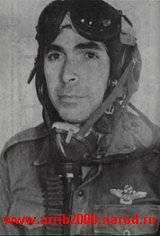 Carreras
was born in 1923. Her father was corporal of the Cuban Constitutional Army
and the mother home working. They has six children. Carreras grow in Matanzas,
where seeing the flying boats in the bay, and then he was impassioned for the
aviacion. He income to the Army by means of the Emergency Military Service
(SME). Already in the Army, he aspire to a place of aviation cadet. He step
all the tests and was accepted at the end of 1942. Carreras finishes the
studies March 25, 1944. "I achieved my dreams" says. During the remainder
of the Second World War he patroled the Cuban water in search of Germans submarines.
Carreras
was born in 1923. Her father was corporal of the Cuban Constitutional Army
and the mother home working. They has six children. Carreras grow in Matanzas,
where seeing the flying boats in the bay, and then he was impassioned for the
aviacion. He income to the Army by means of the Emergency Military Service
(SME). Already in the Army, he aspire to a place of aviation cadet. He step
all the tests and was accepted at the end of 1942. Carreras finishes the
studies March 25, 1944. "I achieved my dreams" says. During the remainder
of the Second World War he patroled the Cuban water in search of Germans submarines.
When the coup d'etat of Fulgencio Batista in March of 1952, Enrique
Carreras is ascended to Captain Assistant of the General Stab Chief, the Colonel
Eulogio Cantillo that until that moment was the Army Aviacion Corp Chieff.
Then he passes to the aviacion again, and he is appointed as leader of the Escuadron
de Combate of F-47D Thunderbolts. He participates in conspiracies against
Batista, and in 1957 the lieutenant Alvaro Prendes attracts it to the Movement
26 of July of Fidel Castro. In September 5, 1957 is produced the revolt in Cienfuegos,
and Carreras as leader of the F-74D Squadron, sabotages the order of bombarding
the revolts sailors. By this accion Carreras is imprisoned, where remains until
the revolutionary triumph of January 1, 1959. The first one accion upon
leaving of the carcel went of participating in the investigations for the judgment
against the aviators of the Batista's Air Force. He participates in several purges
to the personnel of the Air Force, separating of the Corp the not revolutionary
personel. Carreras is since the firsts times one of the leaders of the Fuerza
Aerea Revolucionaria (FAR). After the flight of Diaz Lanz to USA, Carreras occupies
the charge of Leader of the Escuadrón de Persecución y Combate (Pursuit
and Combat Squadron). Carreras gave classes of flight to the Che Guevara
and to Raul Castro at the beginning of the revolution.
During the Bay of Pigs combats in April of 1961, the captain Carreras is one of the pilots of more important success. On April 17 he receives the personal order of Fidel Castro of attacking the ships that transport the invading troops, and with rockets of his Sea Fury, he sunk the Houston ship, that transporting important loads for the disembarked troops, which strike them harshly. He shoot down two B-26: the first one April 19 in his Sea Fury, and another B-26 April 19 in a T-33. In total does 7 missions, and he was the unical pilot that flew in the three combat airplanes types of the FAR: Sea Fury, B-26 and T-33.
He was the first pilot in Cuba to flying the MiG-15 and MiG-19, and is appointed as Leader of the first Escuadron de Cazas (Fighter Squadron) of MiG-15bis. When the Missile Crisis in October of 1962, he represents the Air Force at the leader of operations of the General Stab of the Armed Forces, the Major Flavio Bravo. Carreras was later Military Attache in Peru, Mexico and Portugal, went the leader of a delegation of the DAAFAR to Vietnam during the war with USA. In 1976 the Major Carreras is designed leader of the Cuban Aviation in Angola. In 1988 he stops flying (at the age of 65 years), and in 1994 he is ascended to Division General. At present he lives retired in Havana. He was condecorated with the holder of Hero of the Republic of Cuba. Carreras published his memories in the book 'Por el dominio del aire' ("For the Air Control", 1995).
![]() Julio Casas Regueiro
Julio Casas Regueiro
Army
Corp General. DAAFAR's Chief in 1980-1987 and 1999-2000
Today he is the head of the Headquarters and Vice-minister for the Rear, Substitute of the Minister. As responsible for the economical activity of the MINFAR, directs companies as the turistical company "Gaviota" (with his airliner Aerogaviota), and the Union of Military Enterprices. His brother Senen Casas Regueiro was too a FAR General, and Transportation Minister, before dies in 1996.
The today Army Corp General Julio Casas Regueiro, was head of the Anti Aircraft Defense and Revoliutionary Air Force (DAAFAR) during 8 years, from 1980 to 1987 and in 1999-2000. From february 2008 to his dead at september 2011, Corp General Julio Casas Regueiro was Defence Minister. He died on September 3, 2011, in Havana.
![]() Jaime Gonzáles Grocier
Jaime Gonzáles Grocier
Captain,
Cuban Aviation Pioneer
Jaime
Gonzalez is one of the protagonists of the Cuban aviation birth. On February 23,
1914, trying to land around las18.20 in Cienfuegos, Jaime Gonzalez collides with
an column, damaging the airplane. This was the first aviation accident in Cuba.
He begins the first flights that cross Cuba. In May of 1914 Jaime carries out
one of the more longs flights of the epoque, from Cienfuegos to Havana (285 km).
To the next year, in May 27, 1915, he made the first flights Havana - Santiago
de Cuba, with scales, a flight of 7 hours of duration in a Morane
Saulnier G.
In October 19 of 1915, Jaime Gonzalez was commissioned with the degree of Honorary Captain, and its aircraft Morane Saulnier G, that previously was been property of Agustin Parla, become the second Cuban military aircraft. In February of 1917 he performs flights throwing propaganda against the rebelion of the "chambeloneros". In 1920 Gonzales unite the western coasts with the orientals coast, in its monoplane Bleriot, and joins with several cities by the air, being these the first flights to the large of Cuba. This same year Jaime Gonzalez made the first postal flight in Cuba. In July 4, 1920 Jaime Gonzalez dies when crashed after take off from the farm La Bien Aparecida, in Luyano, Havana, falling in the farm La Fernanda, by the bridge Alcoy. This it was the first fatal accident of the Cuban Civil aviation. Today its name carries the Cienfuegos airport.
![]() Rubén Martínez Puente
Rubén Martínez Puente
Division
General. DAAFAR´s Chief in 1987-1999 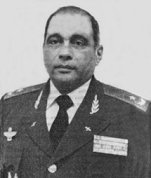 He
was born in Santiago de Cuba on April 15, 1942, but was recorded in 1944 in Guantanamo,
where course the studies of primary and secondary. He is one of four brothers,
two females and two males, the father was professional member of the Socialist
Party (Communist). Martinez works in diverse places, and in 1958 he joins the
guerrillas of the II Front of Raul Castro. In 1959, after the revolutionary
triumph, he is sent to Mexico to pilot courses, and in June of 1960 travels to
Checozlovaquie to assimilate the MiG-15, returning in 1962. He occupies
diverse charges, as head of diverse fighters units in Santa Clara and San Antonio
de los Banos.
He
was born in Santiago de Cuba on April 15, 1942, but was recorded in 1944 in Guantanamo,
where course the studies of primary and secondary. He is one of four brothers,
two females and two males, the father was professional member of the Socialist
Party (Communist). Martinez works in diverse places, and in 1958 he joins the
guerrillas of the II Front of Raul Castro. In 1959, after the revolutionary
triumph, he is sent to Mexico to pilot courses, and in June of 1960 travels to
Checozlovaquie to assimilate the MiG-15, returning in 1962. He occupies
diverse charges, as head of diverse fighters units in Santa Clara and San Antonio
de los Banos.
In 1977 he was one of organizators of the Operation Pico against the Dominican Republic. En 1983 dirige la aviación cubana en los combates por Canganba, Angola.
In 1983 he directs the Cuban aviacion in the combat by Canganba, Angola.
Being already Brigade General in 1987, and chief of troop of the DAAFAR, when begans the combats near Cuito Cuanavale, is appointed leader of the DAAFAR in November of 1987, substituting the Division General Julio Casas. Take part as member of the Cuban delegacion that signs the peace agreements of the war of Angola. He is member of the Central Comite of the Communist Party, and Division General.
In 1999 he yields the charge of head of the DAAFAR again to the General Julio Casas.
![]() Pedro J. Mendiondo Gómez
Pedro J. Mendiondo Gómez
Brigade
General, Actual DAAFAR's Chief since 2000
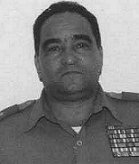 He
was born in August 13, 1945. To the revolutionary triumph, he joins the Youthful
Patrols and later to the Young Rebels Association. In 1961 he studies artillery,
and during the Missile Crisis of 1962, he is incorporated to a Popular Defense
Batallion as company leader. He enters to the Revolutionaries Armed Forces in
1963, to the Military School of San Julian.
He
was born in August 13, 1945. To the revolutionary triumph, he joins the Youthful
Patrols and later to the Young Rebels Association. In 1961 he studies artillery,
and during the Missile Crisis of 1962, he is incorporated to a Popular Defense
Batallion as company leader. He enters to the Revolutionaries Armed Forces in
1963, to the Military School of San Julian.
After graduating he occupies different places in units of the Anti-Aircraft Defence and Revolutionary Air Force (DAAFAR), until to be named its General Stab Chieff. He complies mission in Angola, where is ascended to the degree of colonel. By proposal of the Minister of the Revolutionaries Armed Forces, the State Counsel of the Republica of Cuba have been conferred him, among others, the Order by the Service to the Country, the medals 'Ignacio Agramonte' and Internacionalist Fighter. Graduate of the Hight Military Colleges. At the end of the 2000 year he substitute to Ruben Martinez Puente as Leader of the DAAFAR, with the degree of Colonel even. In January of 2001 he is ascended to Brigade General.
Mendiondo died on August 25, 2013 in an automobilistic accident.
|
|
|
|
|||





